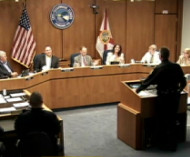Article from: www.thenewspaper.com/news/45/4504.asp
9/3/2014
Florida: City Council Embraces Accident Causing Cameras
Accidents increased 11 percent at red light camera intersections in Clearwater, Florida.
 After two years of photo enforcement use in Clearwater, Florida, the data show that accidents increased where red light cameras were installed. At a work session on Tuesday, the city council celebrated the results.
After two years of photo enforcement use in Clearwater, Florida, the data show that accidents increased where red light cameras were installed. At a work session on Tuesday, the city council celebrated the results.
Chief Dan Slaughter made a presentation to the council that painted the performance of the cameras in the most positive light possible. The city's crash data covered a "before" period of July 2011 to June 2012 which he compared with two six-month "after" periods of July 2012 to June 2013 and July 2013 to June 2014.
The results were confused by the city's lack of complete data in the before period, which left out accident reports filled out on what is known as the short form. This typically includes most of the rear end collisions. Judging based solely on the more serious long form accident reports, accidents increased an average of 11 percent in the after period, including a fatality at Gulf to Bay Boulevard and Belcher Road. After hearing this, the council's enthusiasm for photo enforcement did not diminish.
"I guess my question, chief, would be: If we were to move in the direction of increasing our red light cameras, what other intersections would you recommend?" Councilman Hoyt Hamilton asked.
Clearwater generated $241,420 in revenue from the red light camera tickets issued by its Australian contractor, Redflex Traffic Systems at the two locations. The council noted that the city could continue to use cameras because the state legislature did not move to ban them.
"The other thing that is favoring the continuation of this at the state level is that the state gets the biggest part of the fines that are collected," Councilman Bill Johnson said. "They're beginning to realize the importance of the collections at the state level, which are probably more than at a city level like Clearwater."
Clearwater earns less than some other cities because it abides by state law that prohibits the issuance of photo tickets to drivers who make safe, rolling turns on red.
"It was because of some issues with the statute we weren't comfortable with," Chief Slaughter said. "We still don't use [right-turn ticketing] to this day."
Chief Slaughter pointed to a downward trend in the accident rate in the after period from 2013 to 2014 as evidence of the cameras' success, but this result cannot be attributed solely to the presence of cameras. On May 31, 2013, the Florida Department of Transportation revised its formula to mandate slightly longer yellow times. The impact of the change was immediate. At Chestnut Street and South Fort Harrison Avenue, the average violation rate fell by nearly half from 0.05 percent to less than 0.03 percent. At Gulf to Bay Boulevard and Belcher Road, the violation rate fell below 0.02 percent with the longer yellow.
"There is a period where the yellow light was implemented," Chief Dan Slaughter said, pointing to a violation chart. "You can see that did have a positive impact as well."
 After two years of photo enforcement use in Clearwater, Florida, the data show that accidents increased where red light cameras were installed. At a work session on Tuesday, the city council celebrated the results.
After two years of photo enforcement use in Clearwater, Florida, the data show that accidents increased where red light cameras were installed. At a work session on Tuesday, the city council celebrated the results.